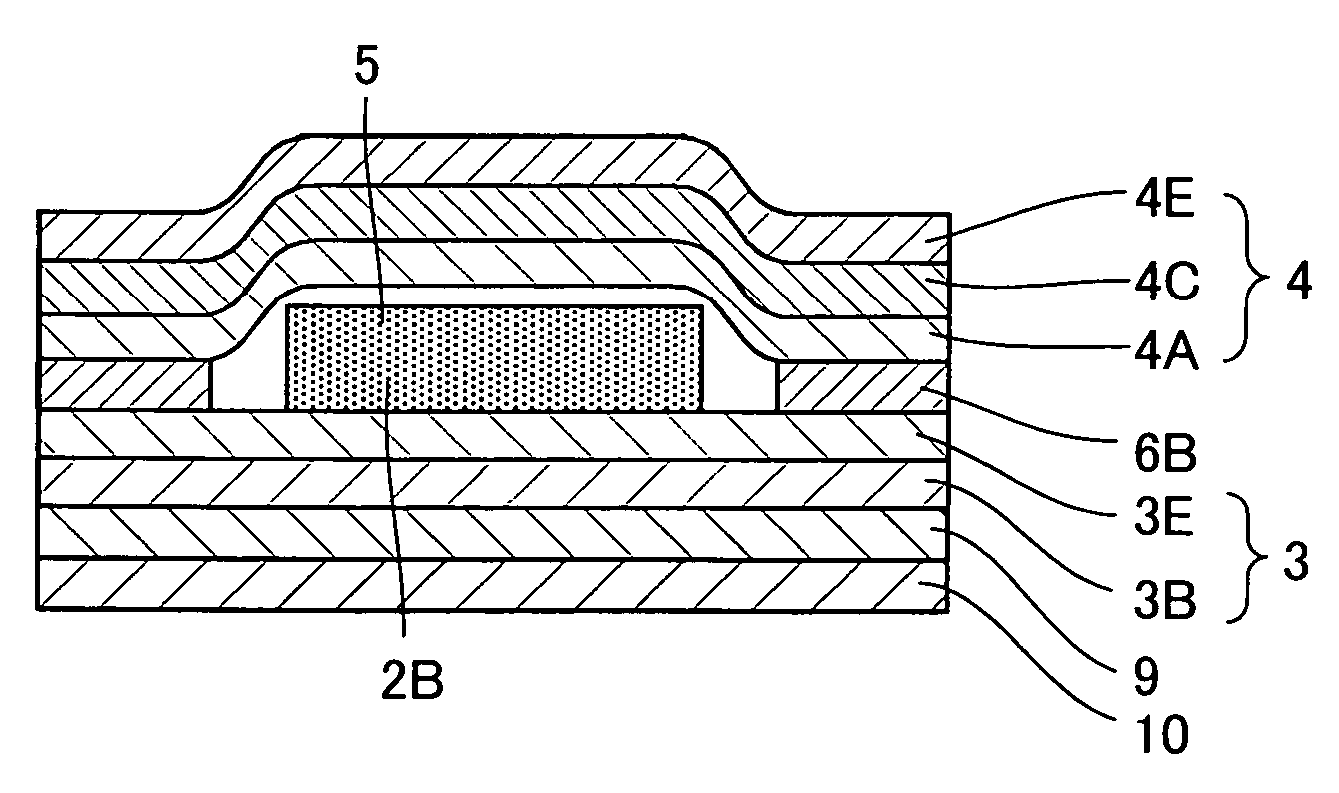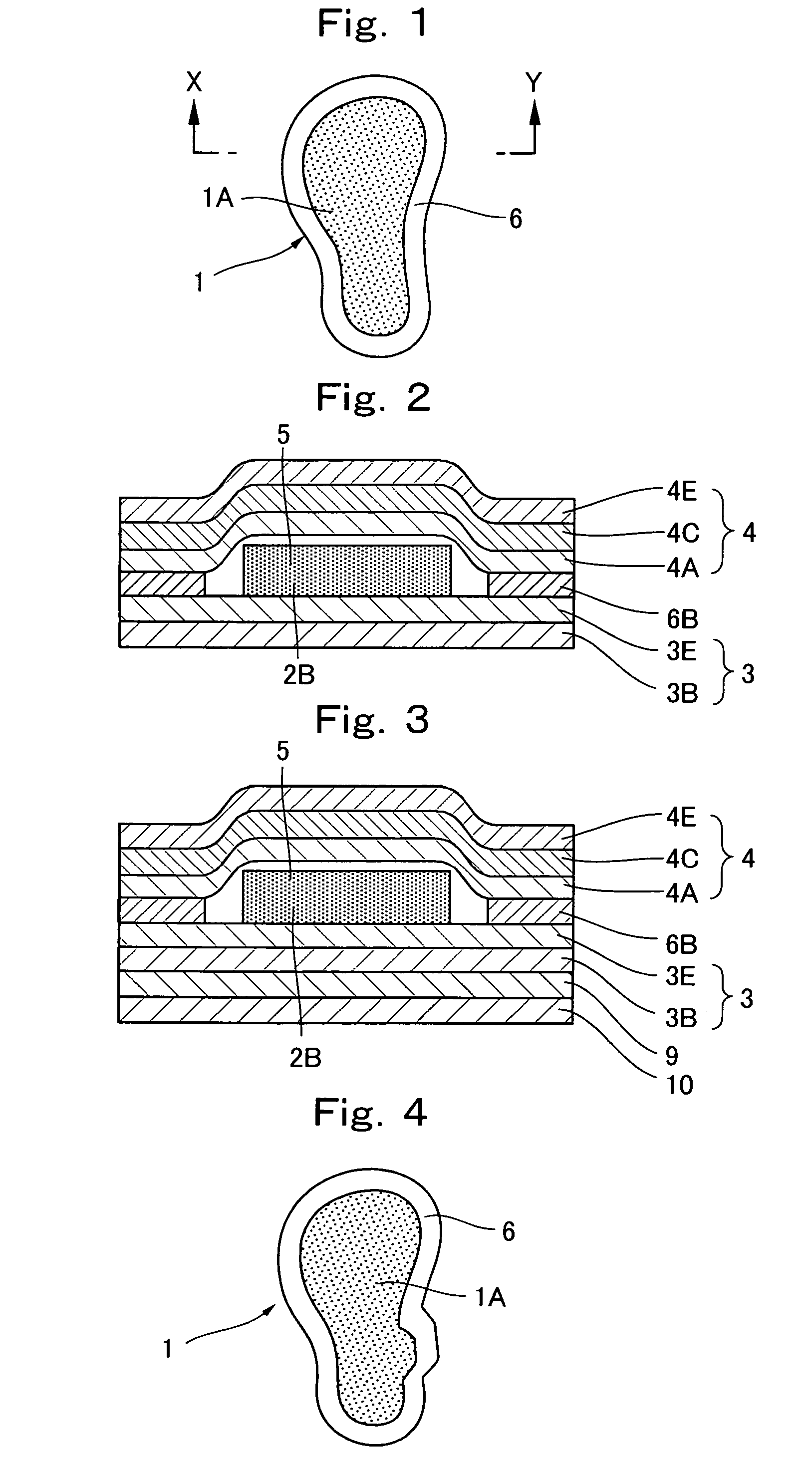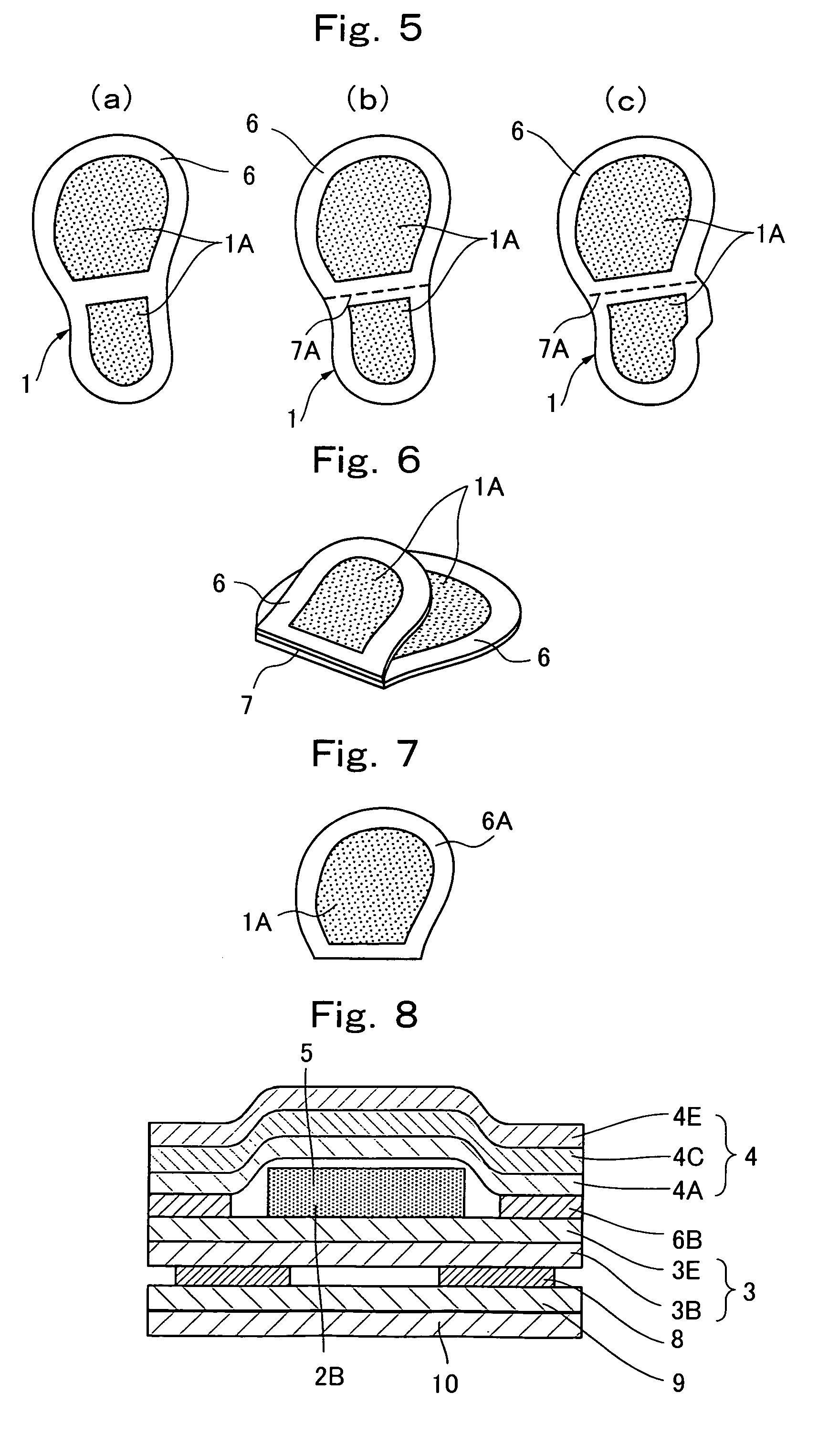A method for fixing a heat-generating composition with a cohesive agent is proposed in JP-A-S62-347, but it is substantially impossible to adhere a
powder heat-generating composition on an inside of a bag body in practical productions, and even if it is possible, it lacks in practicability because the
adhesion strength is small to fail to attain complete fixing, which causes releasing during the use, the use feeling is deteriorated due to a platy shape having poor flexibility, and in addition, contact with air is considerably impaired due to the presence of the mixed adhesives to cause nonuniformity and fluctuation in temperature.
A heat-generating body for warming foot having a prolonged heating duration is difficult to produce at a high speed, and migration of the heat-generating composition inside the container bag occurs upon use to deform the heat-generating body itself, and thus the use feeling is considerably deteriorated.
On the other hand, such a heat-generating body for warming foot that can be produced at a high speed, in which the heat-generating composition does not move inside the container bag during use to prevent the heat-generating body itself from deformation has a short heating duration and has problems as a practical product.
That is, in a heat-generating body for warming foot having a conventional
powder heat-generating composition, the heat-generating body for warming foot is bulky in total and is poor in texture with stiff feeling.
Furthermore, it is poor in flexibility and is difficult to fit complex unevenness and curved surfaces with small curvature on the surface of a
human body.
Moreover, since the elongation property or the stretch property is lowered, the heat-generating composition moves associated with movement of the
human body, and the heat-generating body is deformed, whereby the followability of the heat-generating body to the surface is deteriorated to cause such a problem that the use feeling is considerably deteriorated.
The heat-generating body having a conventional
powder heat-generating composition can follow only a rough curved surface and partially causes warpage due to misfit in curved surfaces depending on the kind of shoes, so as to cause pain on foot by pressing foot, whereby the applicable shoes are restricted to provide significant unsatisfaction.
In the heat-generating body having a conventional powder heat-generating composition, although the heat-generating composition is imparted with wettability with water, the
mixing ratio of water is as low as such an extent that is suitable for the heat-generating reaction, and it is in the form of powder and is poor in flowability.
Therefore, it is considerably difficult to be uniformly distributed within the prescribed region on the base material, and thus the thickness of the heat-generating composition is fluctuated inside the heat-generating body for warming foot, whereby the heat-generating composition moves inside the inner bag, or the heat-generating composition is deviated due to deviation and bending thereof, so that the thickness of the heat-generating composition inside the heat-generating body for warming foot becomes unequable.
Accordingly, in the case where it is used by fixing on a
human body, it causes such serious problems in that there are cases where ambustion occurs due to the unevenness in
heat generation temperature distribution upon using by fixing on the same position, the
skin receives a powerful stimulus, dermopathy, such as rubefaction, eruption,
skin fit, arises.
In the method for fixing a powder heat-generating composition with an cohesive, it is substantially impossible upon practical production that the powder heat-generating composition is adhered on the inside surface of the bag material, and even when it is possible, the
adhesion strength is small to fail to attain complete fixation, but it is released during use, and only a plate-like material with poor flexibility is obtained to impair practicality by deteriorating use feeling and by causing unevenness and fluctuation in temperature.
On the other hand, a heat-generating composition using a thickener having a viscous paste or cream form is good in moldability to retain uniformity in thickness, but is restricted in practicality because drainage of excessive water is insufficient, and desired
heat generation amount and heat generation duration cannot be obtained due to influences of the thickener and a binder to fail to produce a
large size product and to fail to obtain a prolonged heat-generating duration.
In the case of the viscous heat-generating composition in a paste or cream form, if the adhesiveness to a base material is poor, a laminated material is peeled from the base material upon molding by pulling by an unlaminated heat-generating composition due to cohesiveness of the heat-generating composition, so as to cause unevenness in thickness, and there are some cases where a normal sole shape cannot be obtained to
restrict the base material.
As a result, the heat-generating reaction occurs after mixing the heat-generating composition but before charging the heat-generating body thus produced in an outer bag, and the
vapor pressure of water in the heat-generating composition is increased to expand the heat-generating body, so as to cause such a problem in that the expanded heat-generating body is difficult to be charged in a packing bag having air nonpermeability.
Furthermore, in the conventional heat-generating composition, a heat-generating reaction occurs after mixing the heat-generating composition but before charging the heat-generating body thus produced in an outer bag to cause loss due to the heat-generating reaction and to deteriorate the quality of the heat-generating composition, and furthermore, the
reaction product formed by the heat-generating reaction is solidified causes various problems, such as reduction in yield, difficulty in handling, complication in maintenance of a production apparatus, restrictions in
operation time of a production apparatus and in working time of an operator, difficulty in
processing the solidified matter, and the like problems.
In the method of intermittently moving a base material and dropping a heat-generating composition during suspension of the base material, there is a problem that the
production rate is lowered due to the frequent repetition of suspension and start-up of the base material.
In the method of moving a base material at a
constant velocity and dropping the heat-generating composition on the base material while moving the dropping mesh for dropping the heat-generating composition at the same velocity as the base material, although the
production rate can be increased since substantially no repetition of suspension and start-up of the base material occurs, a complicated mechanism is necessary for moving the dropping mesh for dropping the heat-generating composition at the same velocity as the base material, and moreover, there is a problem that the velocity of moving the mechanism is greatly restricted because the heat-generating composition contains powder and water and is poor in flowability.
Although the conventional powder heat-generating composition is imparted with wettability with water, the
mixing ratio of water is as low as such an extent that is suitable for the heat-generating reaction, and it is
extremely poor in flowability, whereby it is significantly difficult that the composition is uniformly distributed within the prescribed region on the base material only by simply dropping thereon.
A heat-generating composition in a
slurry form with less
viscosity cannot maintain the shape to fail to attain molding into a constant shape, and it is then molded through a complicated step, such as paper making.
 Login to View More
Login to View More 


